Look at the most beautiful pink-leaf plants to add a charming accent to your garden with these best options.
Pink leaf plants can be a charming addition to your outdoor settings. The beautiful hues and patterns add a fresh burst of color and style. Include them to your plant collection for an aesthetic appeal.
Pink Leaf Outdoor Plants for Year-Round Color
1. Cordyline
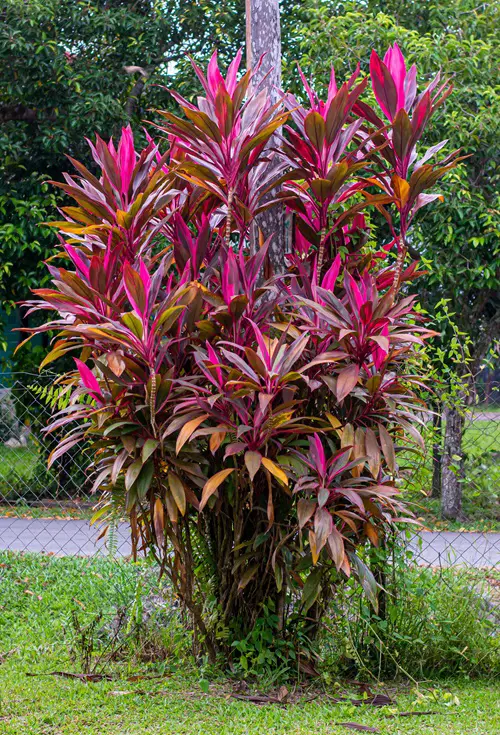
Botanical Name: Cordyline
Best Varieties: Cordyline australis ‘Pink Passion’; Cordyline fruticosa ‘Kiwi’; Cordyline fruticosa ‘Red Sister’; Cordyline fruticosa ‘Pink Diamond’
USDA Zones: 9-11
Cordyline is a tropical plant with long, oblong, deep pink, and often variegated leaves that can grow up to 10 feet outdoors. The hues get intensified with ample sunshine. This plant thrives in high humidity and needs regular hydration with distilled water, as it is fluoride-sensitive.
2. New Zealand Flax

Botanical Name: Phormium tenax
Best Varieties: Phormium ‘Pink Stripe’; Phormium ‘Maori Maiden’; Phormium ‘Jester’; Phormium ‘Pink Panther’
USDA Zones: 9-11
The New Zealand Flax is an evergreen perennial of the daylily family. It grabs all your attention with its showy flowers and bright pink foliage! The magenta-tinged, sword-like leaves can be 3 to 8 feet tall, and phormium prefers average, well-drained soil.
It thrives in full sun to partial shade in moderate, balanced heat. Most cultivars display the strongest shades of pink when kept in shade.
3. Caladium
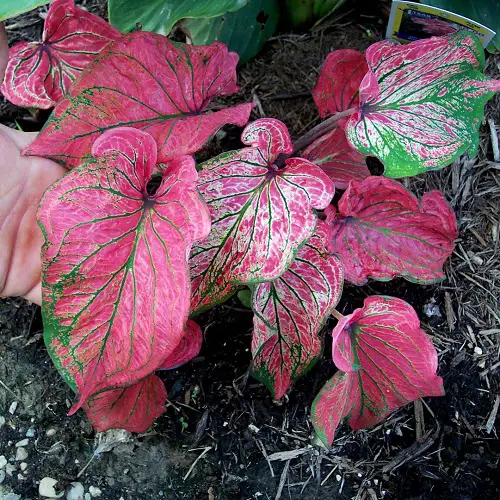
Botanical Name: Caladium
Best Varieties: Caladium ‘Pink Symphony’; Caladium ‘Miss Muffet’; Caladium ‘Carolyn Whorton’; Caladium ‘Raspberry Moon’
USDA Zones: 9-11
Caladium will surely steal your heart with its heart-shaped leaves that emerge in a distinct pinkish peach. It is a small ground cover, reaching 1-2 feet tall, but growing a row of caladiums will surely turn heads with its heart-shaped leaves and hot pink veins running through it.
This plant thrives in moist, well-drained soil and ample shade. It is a heavy feeder, so give it any balanced fertilizer, like 10-10-10, at least once a month.
Note: Caladiums are toxic due to calcium oxalate crystals that cause severe pain and burning if ingested.
4. Joseph’s Coat

Botanical Name: Alternanthera ficoidea
Best Varieties: Alternanthera ficoidea ‘Pink Lady’; Alternanthera dentata ‘Little Ruby’; Alternanthera ficoidea ‘Red Threads’
USDA Zones: 10-11
Joseph’s Coat can be grown as a perennial or annual, but in both cases, its sharp pink beauty wows the onlooker! Its bright foliage comes in several hues, but we love the pinkish-purple. A cool story behind its name is that the biblical figure Joseph created a coat with the leaves of this plant.
This plant has toothed leaves that produce the strongest color when planted in moist, fertile soil and exposed to bright sunlight. Due to how quickly and vastly it spreads, it either needs constant pruning or a lot of space!
5. Pink Lady Callisia
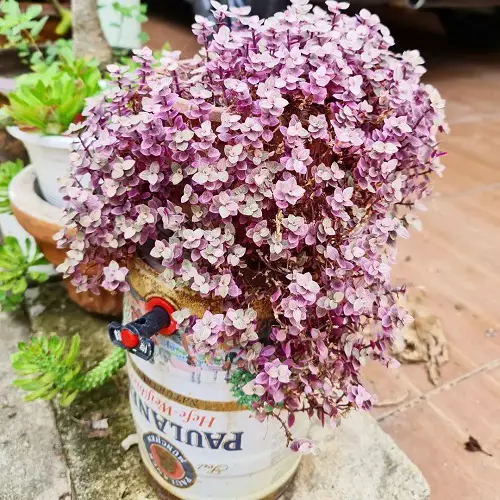
Botanical Name: Callisia repens ‘Pink Lady’
USDA Zones: 9-11
This low-growing perennial is not common in most outdoor garden spots. However, if you plant it in your backyard, it will be the talk of the town. Pink Lady Callisia has small, waxy, pinkish leaves and a ground-hugging form.
It is a creeping plant with trailing stems that can form a carpet of foliage about 6 inches tall. It can survive with little to no care and performs best with limited water and less exposure to sunlight.
6. Coleus

Botanical Name: Coleus scutellarioides
Best Varieties: Coleus ‘Pink Chaos’; Coleus ‘Watermelon’; Coleus ‘Pinkplosion’; Coleus ‘Dipt in Wine’
USDA Zones: 9-11
This tropical member of the mint family, native to Asia and Australia, might have the iconic mint leaf look, but the color is what sets it apart! It grows as an annual outdoors and is known for its bold, pinkish-red leaves.
It grows up to 3 feet tall and needs moist, rich, loose soil and partial shade. Full sun causes the plant to burn, while full shade causes it to get leggy and less colorful.
7. Heuchera
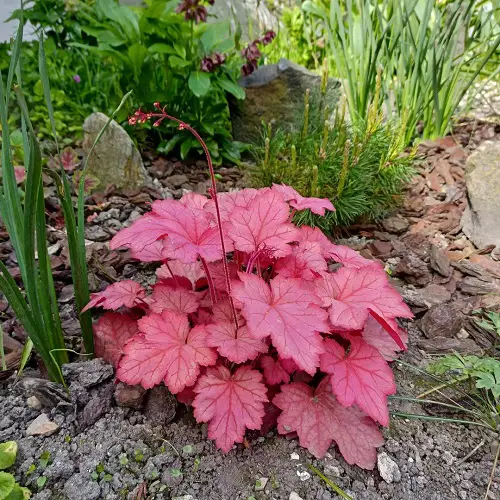
Botanical Name: Heuchera
Best Varieties: Heuchera ‘Berry Smoothie’; Heuchera ‘Georgia Peach’; Heuchera ‘Fire Alarm’
USDA Zones: 3-9
Also known as Alumroot or Coral Bells, Heuchera is one of the most popular outdoor plants for adding a bit of color to your surroundings. It has deep pink leaves, grows better in cooler climates, and is used as ground cover.
It forms a compact mound about 16 inches tall with scalloped, velvety leaves. Depending on the variety, heuchera can be grown in full sun or partial shade. Some produce better color in well-lit conditions, but almost all varieties prefer a slightly acidic pH and moist, well-drained soil.
8. Polka Dot Plant

Botanical Name: Hypoestes phyllostachya
Best Varieties: Hypoestes phyllostachya ‘Pink Brocade’; Hypoestes phyllostachya ‘Splash Pink’; Hypoestes phyllostachya ‘Confetti Pink’
USDA Zones: 9-11
While grown initially only as a houseplant, the Pink Polka Dot Plant is now cultivated as an outdoor annual. With distinct bright pink spots on its leaves, this plant makes an excellent border.
Native to Madagascar, its ovate leaves may also be green but have numerous small dots or splats of a pink shade. It is typically around a foot tall and thrives in indirect sunlight and consistently moist, well-drained soil.
9. Pink Muhly Grass
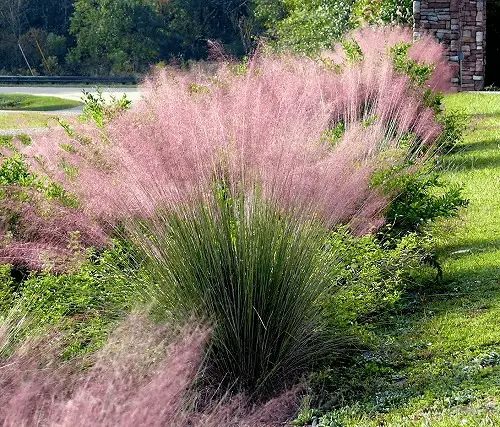
Botanical Name: Muhlenbergia capillaris
USDA Zones: 5-10
This ornamental grass has delicate pink plumes of flower panicles that grow atop the green, glossy foliage. Although this pink is not entirely on its leaves, its different plant parts are almost indistinguishable.
This grass will add color to your garden in fall or early winter when most other plants go barren. It grows up to 4 feet tall and thrives in clay or thin rocky soils, especially if the medium was previously burnt.
10. Smoke Tree
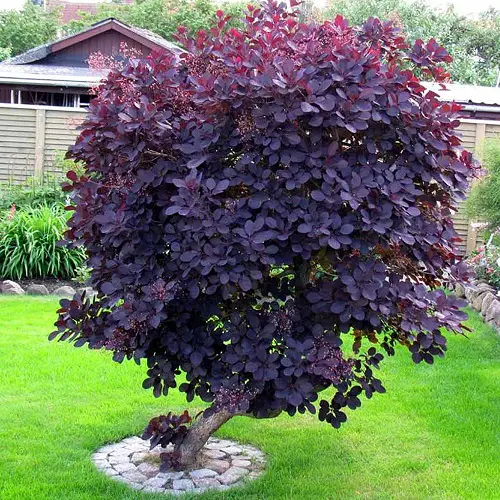
Botanical Name: Cotinus coggygria ‘Royal Purple’
USDA Zones: 4-8
This stunning tree has deep, rosy purple foliage and airy pink blooms! During summer, the leaves are greenish blue, but as soon as fall draws near, they turn bright pink to a purplish red!
This tree is a master adapter and can grow in acidic, neutral, and alkaline soil. But the only constant is that it prefers full sun.
11. Chinese Fringe Flower

Botanical Name: Loropetalum chinense
Best Varieties: Loropetalum chinense ‘Ruby’; Loropetalum chinense var. rubrum ‘Razzle-Dazzle’
USDA Zones: 7-10
Certain varieties of the Loropetalum have pink-tinged, finely textured, oval leaves with matching ruffled or fringed spring blooms. This pop of color is perfect for outdoor gardens.
It has a bushy habit and thrives in both full sun and partial shade. It also prefers well-drained, slightly acidic soil. Prune it to keep it in check to maintain its shape, especially if you’re using it as a hedge plant, once it has finished blooming.
12. Sedum
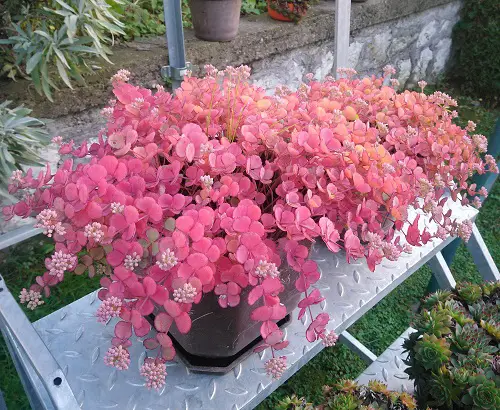
Botanical Name: Sedum
Best Varieties: Sedum sieboldii; Sedum spurium ‘Tricolor’
USDA Zones: 3-11
While most sedums are known for the eye-pleasing combo of fleshy greenish-blue leaves and bright pink flowers, there are some whose foliage, too, takes on a rosy hue! Sieboldii has deep blue leaves with hot pink margins, while Tricolor has light pale green leaves with pinkish-white edges.
They thrive outdoors in sunny spots and well-drained soil. Since they are succulents, they do not require much water and can survive in drought-like conditions.
13. Dracaena
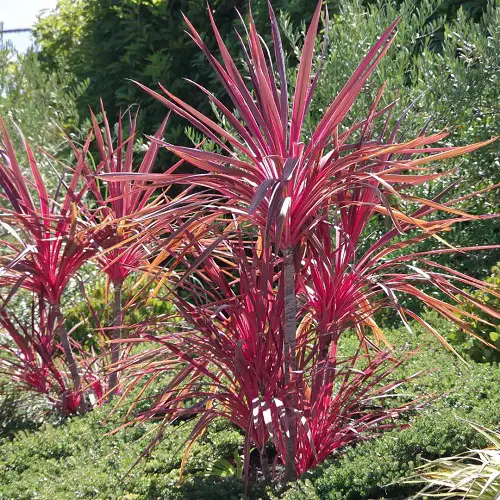
Botanical Name: Dracaena marginata
Best Varieties: Dracaena marginata ‘Tricolor’; Dracaena marginata ‘Colorama’; Dracaena marginata ‘Magenta’
USDA Zones: 9-12
Dracaena marginata is often confused with cordyline due to its similar looks. Dracaena, too, has long, linear, sword-like leaves. The cool part is that most cultivars are not mono-colored but show off green, pink, red, or white fusions.
This compact shrub can scale up to 20 feet, making it well-suited to grow outdoors. It loves bright, indirect light and well-draining soil.
Tip: This plant is sensitive to even the smallest amounts of chemicals and contaminants in water. This kind of water can cause discoloration and diminish its charm. Use distilled water for best results.
14. Wandering Dude

Botanical Name: Tradescantia
Best Varieties: Tradescantia pallida ‘Pink Nanouk’; Tradescantia fluminensis ‘Tricolor’; Tradescantia zebrina ‘Quadricolor’
USDA Zones: 8-12
Finally, we have a really common houseplant in our list of plants with pretty pink foliage—the Wandering Dude! Appearing in pink and purple, it can also be grown outdoors in warm climates. This trailing plant grows up to a foot tall and has oval leaves slightly pointed at one end.
Growing this plant is easy, as it can adapt to a wide range of conditions. However, it does best in filtered sun, average room temperatures, and moist but well-drained soil. Pruning and pinching back growth can encourage a bushier look.


